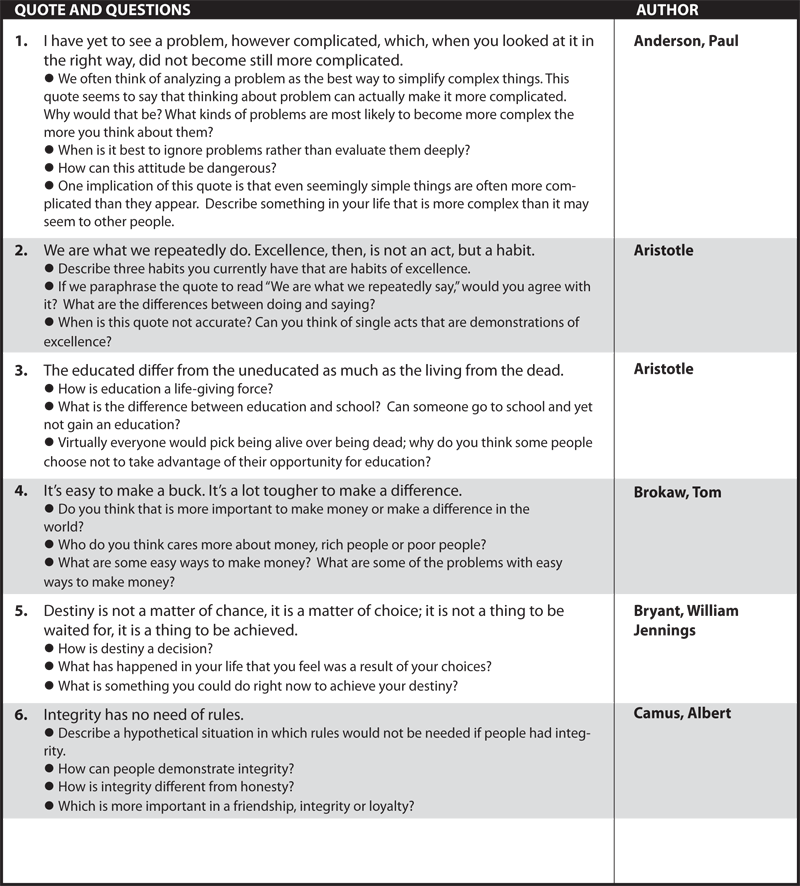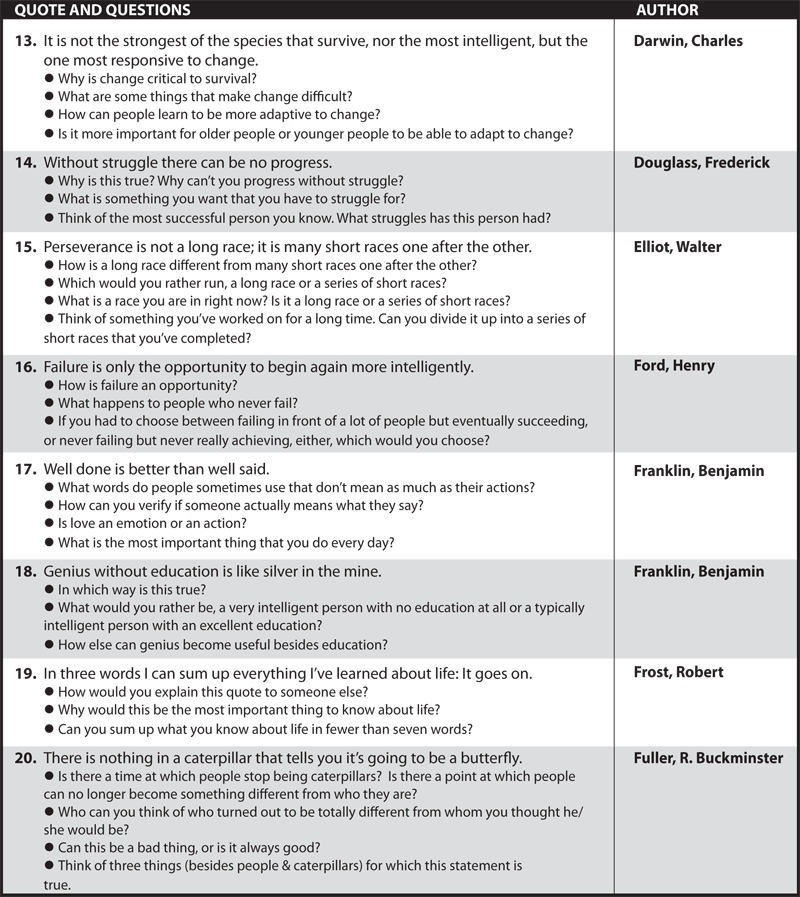Meta-cognition (thinking about thinking) often fascinates gifted learners, and quotations are an accessible and time-effective way to introduce this in the classroom. Quotes lend themselves easily to critical thinking skills, and they are as useful in the home as conversation starters as well.
How can teachers use quotations in class to inspire, encourage, increase motivation, and develop high-level thinking skills?
This plan contains 65 quotes appropriate for classroom use listed by author of the quote, along with specific response questions for each quote. Additionally, there is a comprehensive section on how to use quotes in the classroom in a variety of ways. Each of these is explained in the applicable section.














Here are 20 ideas for activities students and teachers can do with quotations (either the ones here or others).
Idea 1
Quote comparison: Either randomly or with deliberate intention pair quotes for comparison and contrast. Here are some general questions to accompany the quotes:
Idea 2
Quotation family: Create a quotation family by selecting two parent quotations and then finding other quotations whose ideas stem from the parents, including explanations of how they are connected.
Idea 3
Tag cloud: Make a tag cloud of favorites or put all quotes in a tag cloud (use Tagxedo or another word cloud creator) and see what words appear most often.
Idea 4
License plate: Create a license plate that captures the idea of a quote. Find a template here. This site has templates for each state, so students can create a license plate for their home state or a state that they feel matches the tone of the quote.
Idea 5
Create a conversation: Have students select a series of quotes and organize them into a conversation with the quotes responding to each other. They may change the quotes into questions in order to make the conversation flow, if they desire.
Idea 6
Make a movie or slideshow: PowerPoint has the ability to convert the presentation to a movie. You can also download Microsoft’s Photostory (for PC users). You can also use the free (registration required) Kizoa.
Idea 7
Integrate: Use quotations to decorate the room, add them to assignments, create a bulletin board to highlight them, or buy a simple frame and replace the quote in it regularly.
Idea 8
Top 10 Lists: Have students compile Top 10 lists of quotations for characters in stories, people in history, or categories within the quotes themselves (top 10 quotes by people still living, top 10 quotes by Americans, top 10 quotes under 150 letters, etc.).
Idea 9
Most Likely to Be Used Lists: Have students match quotations to occasions or people. What quote is most likely to be used by a person or in a certain situation?
Idea 10
Yoda-cize: Have students change the syntax of a quote to match the way Yoda would say it (e.g., cannot hold a man down without staying with him you must).
Idea 11
Make into inspirational poster: You can do this for free and easily at Big Huge Labs. Find images from Flickr (use advanced search to find results with Creative Commons licenses) or at freeimages (again, used advanced search to select unrestricted photos). The image used in the example was a free image from iStock photo.
Idea 12
Make into a book: Desktop publishing makes printing an actual book simple, but another idea is to save a document or PowerPoint (tip: designing is easier in PowerPoint than Word) as a PDF, and then upload to flipsnack, a site that will convert the PDF into a flip book for free.
Idea 13
Match game: Match quotes to the curriculum or current events. What quote could be the epitaph of whatever it is the class is studying? Although it is simple and straightforward for language arts and social studies, it is also effective for math, science, and other content areas.
Idea 14
Origami: Have students write quotes on paper that they fold into origami shapes. Encouraging quotes can be folded into cranes and given to students or faculty or community members who are in need of encouragement. For instructions for a variety of origami folding projects, visit https://origami-instructions.com. There is also a helpful video on Youtube.
Idea 15
Bracket challenge: List the quotes by number on a bracket challenge template. Have students vote on their favorites, and advance over time to a winner. This is an effective home/school connection idea, as you can allow parents to vote as well.
Idea 16
Make a visual: Have students select an image (see Idea 11 for image sources) and add the text, carefully selecting an appropriate font. Have students save the images and use them to create collages, print them to create photo albums, or use them in other projects (such as a flip book).
Idea 17
Print them on sticky notes: You can find an easy tutorial that describes how to print onto sticky notes directly from your computer. Students can then leave inspiring quotes around the school or their homes. Teachers can also leave quotes on student desks.
Idea 18
Tweet them: There is a Twitter hashtag (#quotes) that you can use to share quotes. Alternately, students can paraphrase quotes into 140 characters just on paper. Use a Twitter icon to label them.
Idea 19
Create a Geocache: Students or teachers can leave quotations in small notebooks or sticky note pads that they geocache. Finders can add a quote and take a quote. Find out more about geocaching in general and get classroom ideas here.
Idea 20
Padlet: Padlet (formerly Wallwisher) is a virtual blank wall on which people can post "notes." Teachers or students can create a board at the site on which others may post. This free site allows students to interact, even with students in other schools or class periods.
Can’t get enough quotes? Here are some places to find even more great quotes!
quotabl.es is a searchable British site and community for quote-ophiles. You can find great quotes, yes, but you can also rate those others have posted and share your own. When you register (free), you can create a database of your own favorite quotes, separated by topic.
For all of you math teachers who think quotes are just for the Liberal Arts folks, numberquotes.com is for you. You simply type any number into the search box, and it will generate random (and randomly interesting) factoids that give scale to the number. For example, did you know that 58 pennies stacked on top of each other would be as high as two Burger King Whoppers or that 1 million McDonald’s Big Macs would weigh as much as 30 African male elephants?
It’s not just Yoda who generated great movie quotes. Films are replete with wonderful, humorous and inspiring quotes on a wide range of topics. subzin.com lets you search for screen quotes with only a fragment of the line. Another similar site allows you to search by topic for words of wisdom from movies.
At quotesecret.com, you can sign up to receive a daily quote via email, or you can visit the site to see the quote of the day. The quotes are accompanied by a thought-provoking question and are typically of the inspirational variety.
The illustrator of Doodle Art Alley took quotations and made them into doodle art that students can color.
This series of lessons was designed to meet the needs of gifted children for extension beyond the standard curriculum with the greatest ease of use for the educator. The lessons may be given to the students for individual self-guided work, or they may be taught in a classroom or a home-school setting. Assessment strategies and rubrics are included at the end of each section. The rubrics often include a column for "scholar points," which are invitations for students to extend their efforts beyond that which is required, incorporating creativity or higher level technical skills.